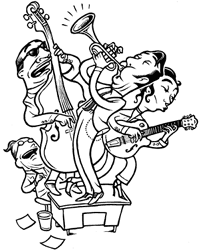Recombinant Innovation
The best new product ideas are hatched by collaboration, not soloists.
 |
|
Illustration by Lars Leetaru |
Counterculture claptrap from an academic wannabe? Not really. While the author of How Breakthroughs Happen (one of strategy+business’s best business books of 2003) does have an academic position (associate professor of technology management at the Graduate School of Management at the University of California, Davis), he also has impressive street credentials. In 1992, as a technical manager at Apple Computer Inc., Professor Hargadon designed and developed a much-admired component of the Apple Macintosh laptop computer: the power transformer “gull wings,” the sleek white retractable tabs that jut out from the power supply so the cord can be elegantly and easily wrapped around them.
Professor Hargadon freely acknowledges that he borrowed (or, as he prefers to call it, “brokered”) the gull-wing idea from the cord tabs on vacuum cleaners. One can trace the concept back from there to the cockpit doors of World War II fighter jets, and perhaps even to actual seagull wings. His own experiences, and the experiences of many others he has studied, have persuaded him that “entrepreneurs and inventors are no smarter, no more courageous, tenacious, or rebellious than the rest of us.
“They are simply better connected,” writes Professor Hargadon.
Context Conversion
Innovators rarely come up with new ideas; instead, they convert old ideas into new ones, adapting them from one context to another. Professor Hargadon calls this “recombinant innovation.” He cites many examples of this process in addition to the gull wings. Marco Polo brought pasta to Italy from China. Henry Ford adapted his automobile assembly-line technologies from meatpacking plant assembly lines. The Reebok “pump” was an athletic-shoe air bladder borrowed from intravenous bag technology. Pop musicians from Elvis Presley to the Byrds to P. Diddy have “sampled” tunes and themes across genres. Even abstruse and highly specialized technologies like polymerase chain reaction have their roots in the existing practices of other genres.
If you are a corporate leader seeking to foster speedy innovation of new and better products, Professor Hargadon’s communal philosophy of innovation is good news. It means you don’t have to rely on independent geniuses. Just put talented, imaginative people in work environments where there is open-minded give and take and a feeling of freedom to introduce the kinds of disruptive ideas that shake up the marketplace and the competition.
But will the company deploy those disruptive ideas? There’s the rub. For below the surface, there’s another, more pessimistic message in Professor Hargadon’s work: Human innovation at its best does not just have a communal nature; it has an uncontrollable and drunken Dionysian spirit.
Inventing new devices and making them pay off is an organizationally messy process that corporations will tolerate only to a point. Indeed, most innovation-promoting practices in corporations, whatever their intent, actually operate not to freely foster innovation but to control it.
For example, the “skunkworks” structure sidesteps bureaucratic control long enough for a small team to produce results — and then reins in the team. Various “whack on the side of the head”–style training sessions constrain creative thinking within an easily controllable sphere; and product life-cycle efforts seek to strike a balance between loosening and tightening controls. Even the current debate between open source advocates and copyright advocates is really a debate about whether a highly controlled environment (like one with lengthy, Draconian copyright restrictions) is better or worse for innovation.
Perhaps the real “innovator’s dilemma,” Professor Hargadon observes, is the danger that true inventiveness poses to an engineer’s employment status when organizational insecurity and controls overpower the Dionysian spirit.
“The early Apple portables were huge hits, for instance,” he says. “Everybody loved them. But internally at Apple, they were basically career-ending failures for some of the people who worked on them.” The innovative process that leads to the kind of insanely great products that Apple is known for has, along the way, false starts, experimental mishaps, and perceived failures that can reverberate adversely on individuals’ reputations.
Much of Professor Hargadon’s work focuses on the reasons companies tend to spend their time holding back the flood of learning for fear of being swept up in a breakthrough wave. He further argues that companies are often better off with only a small amount of innovation: Many of the most successful companies intensively focus on balancing freedom and flexibility with absolute operating efficiency. Intel, for example, restricts its innovation to a few technological domains, and practices fierce control otherwise; once the company is happy with the design of a wafer fabrication plant, it will “copy it exactly” in its other locations, says Professor Hargadon, “down to the paint on the wall.”
Climates of Creativity
In conversation, Professor Hargadon veers back and forth between his two innovation imperatives: connection and control. Although he has a naturally sunny temperament, you can occasionally see flashes of the curmudgeon within, as he grimaces at those who would take lightly the many challenges of building an innovation culture.
Professor Hargadon himself is an open source supporter. “Where did Disney get its start?” he asks rhetorically. “From Steamboat Willie, which was an adaptation of an older Buster Keaton story. Beauty and the Beast, Cinderella, and Sleeping Beauty were all in the public domain.”
But Professor Hargadon doesn’t regard open source, or any generic policy or practice, as a panacea for innovation in itself. Instead, he keeps referring to the culture of the organization — the subtle, informal practices that add up to a corporate ethic and climate.
Professor Hargadon first became interested in the nature of innovative cultures during his time at Apple. His background then included a master’s degree in mechanical engineering from Stanford, and a stint at the celebrated Palo Alto–based innovation design firm IDEO. He had studied then-leading academic books on the subject, such as Revolutionizing Product Development: Quantum Leaps in Speed, Efficiency, and Quality (Free Press, 1992), by Steven C. Wheelwright and Kim B. Clark. But, as he put it in a recent conversation, “All that stuff about how innovation is in the hands of leaders and the way you structure the organization, well, it just didn’t jibe with the life I was living.”
Take brainstorming, for instance. In the early 1990s, prevailing academic thought was that brainstorming didn’t work. When researchers formed brainstorm groups (typically of undergraduates), the sessions were dull and lifeless. Yet at Apple and IDEO, Professor Hargadon had experienced breakthroughs emerging from brainstorming. He only gradually realized the reason: Whereas students had nothing at stake, technologists used the brainstorming sessions as status-seeking opportunities. These were the opportunities, as Professor Hargadon later put it, to “impress other people with the creativity of their thinking.”
However, even though brainstorming intrinsically promoted innovation, other aspects of engineering culture subtly killed it — by making it a status-degrader. For example, like many technology companies, Apple had unconsciously enshrined a rule that engineers should never raise a problem unless they already had the solution. Problems were assigned a letter grade: A for “must-fix,” B for “should-fix,” and C for “might eventually get around to solving.” A true innovator, Professor Hargadon realized, would benefit from having a dozen or so “A” problems listed: This was an invitation for fertile, collaborative experimentation aimed at figuring out workable solutions. But in the Apple culture of that time, having “A” problems was a sign of incompetence. Engineers worked so hard to avoid public mistakes that they suppressed many new ideas rather than risk showing up with half-baked solutions to problems or, worse, no solutions at all.
With such a taboo in place, innovators tend to solve their problems quietly and unilaterally, often working at cross-purposes. One engineer, solving an electronic problem on a new transformer, might inadvertently increase the heat it emits, thereby causing a problem down the road for the engineer working on its mechanical specs. In a complex product development project, such as one for a car or a computer, the unwillingness to talk openly about problems can reverberate around a launch team for weeks or months, with each new “fix” making life miserable for some other engineer on the team.
Fascinated by these kinds of dilemmas, Andrew Hargadon traded in his engineering job for another graduate student stint at Stanford (this time receiving a Ph.D. in industrial engineering), and began to devote himself to the study of innovative cultures, particularly their counterintuitive aspects. His doctoral thesis and subsequent research explored the climate of several institutions known for their consistent introductions of new products and ideas: IDEO and Apple, plus Design Continuum (which invented Reebok’s pump shoe), Xerox Palo Alto Research Center (famous for creating and then squandering the original graphic user interface computer operating system), Hewlett-Packard’s Strategic Process and Modeling Group (noted for supply chain process innovations), Boeing’s Operations Technology Center (noted for manufacturing process innovations), and two of the most prolific sources of technological leaps in human history: the labs run by Elmer Sperry and Thomas Edison in the late 19th century.
Theories and Practices
Step by step, Professor Hargadon began debunking the idea that innovation depends on inventors. Instead, he began looking at the climate of creativity that innovative leaders, from Edison to IDEO’s CEO David Kelley, had put into place.
“IDEO works well,” says Professor Hargadon, “because people from very different backgrounds are thrown together on a project team. They’ve each worked in three or four very different industries, so they might have 15 different bodies of knowledge to draw upon. And they are open to talking not just about their solutions, but about their problems and mistakes.”
Theories of innovation don’t emerge in a vacuum either. As Professor Hargadon notes in his book, the community theory of innovation has broad academic roots. Sociologist Mark Granovetter’s theory of the importance of “weak ties” figures prominently: Innovators don’t benefit just from deep, intensive teamwork, but from casual connections that lead to chance encounters with unfamiliar ideas. Another influence is the “community of practice” concept. A school of theorists including John Seely Brown (the former head of Xerox PARC), Jean Lave, and Etienne Wenger propose deliberately cultivating informal internal knowledge-sharing networks set up to validate and foster creativity throughout the organization. Professor Hargadon also cites the insights of technology critics like author and strategy+business contributing editor Michael Schrage, who argues for “serious play” as a spur to innovation.
There is also plenty of validation for Professor Hargadon’s theories in the real world. Consider how Procter & Gamble drives innovation by connecting multiple business disciplines to its powerful marketing function. The company’s new approach to R&D, called Connect & Develop, encourages R&D in the early stages of its traditional innovation activities in order to incorporate an understanding of how planned products can be marketed and how they will be received by consumers.
Numerous counterexamples show the perils of solitary innovation. Philo Farnsworth, the reclusive inventor of television, died penniless and bitter because he tried to muscle out all prospective partners and collaborators, and lost to more powerful corporate competitors. Interval Research, the pure-research think tank founded by Microsoft billionaire Paul Allen, shut down after six years, apparently done in partly by its own fierce secretiveness.
Another think tank, Stanford’s Center for Advanced Studies in the Behavioral Sciences (CASBS), sequesters its fellowship winners in isolated rooms for seven hours a day for a year. “You’re supposed to spend that time thinking great thoughts,” said former CASBS fellow and current U.C. Berkeley political science professor Steven Weber, author of The Success of Open Source (Harvard University Press, 2004). “It was fun for a little while. But by the time March rolled around, many of us were seriously depressed. We could not wait to get out of there.”
Anecdotes like this primed me to believe the community theory of innovation right off the bat. Indeed, I went to visit Professor Hargadon to ask him to explicate it. His passion for the theory was clear, until I asked him to tell me how he had invented the gull wings.
“I had six weeks’ worth of slow ideation,” he said, “of all the different ways you could wrap a cable.”
“You mean,” I said, “that you and your team invented them on your own?”
He winced visibly. He had spent nights and weekends testing his colleagues’ ideas, eventually merging them into a single innovative device. Now, he couldn’t remember adapting the gull-wing concept from any other source. (Vacuum cleaners don’t count because their cord-hooks don’t retract.) “It’s my faith that the gull wings came from somewhere,” he said. I asked him why it mattered so much for him to demonstrate a lineage to other ideas, and he said that if he had been conscious of the source, it might have saved him several weeks of sleepless nights — the extra time it took to think up the idea on his own instead of brokering it.
Even if (like me) you find this latter point unconvincing, it still doesn’t disprove the community of innovation theory. No doubt, if it hadn’t been for the robust community of thinkers at Apple, Andrew Hargadon’s six weeks of ideation would have been less fruitful. Or, as he put it upon reflection, “The community can help bring individuals to the edge and perhaps offer them a safety net. But that last leap to innovation may still need to be an individual one.”
Fostering Respect
In his book, among the qualities of a truly innovative culture, Andrew Hargadon cites connections across disciplines, a good balance between freedom and constraint, and a community base that has the opportunity to work intensively. Yet the most important quality for a community of innovation is not quite named explicitly. You have to read between the lines to see it: Respect for those who take on the role of innovators in the first place.
Most creative people have two needs they must simultaneously satisfy: an obsessive focus on the problem at hand, no matter where it leads them; and the craving for respectability. Innovators have to show to the company and their peers that they are in control, with an enviable and error-free track record. It’s no wonder that, in trying to do all this, many innovators (and companies) get twisted up in knots. Professor Hargadon gets closest to this point when he writes that most successful innovative labs consciously try to reduce people’s exposure to the highly personal derision and rebuke that is common in innovation cultures.
Take Microsoft. Here is a company known for humiliating smart people, both insiders and outsiders. Yet Microsoft also succeeds in generating continuous internal innovation, because of people like Seamus Blackley. In his leadership role in the innovation of the Xbox, he skillfully tapped professional admiration to combine the ideas of PC and video game innovators — two groups who often malign each other. A deliberate culture of mutual respect, when it’s authentic, is contagious and productive.
It’s understandable that respect is difficult to nurture in an innovative company, because innovators, by their nature, fail more often than other people do. However, Professor Hargadon makes a strong case that the organizations that appreciate innovators as complex human beings, rather than as mere sources of new ideas, are the places where innovation truly flourishes.![]()
Reprint No. 04404
Art Kleiner (art@well.com) is the “Culture & Change” columnist for strategy+business. He teaches at New York University’s Interactive Telecommunications Program. His Web site is www.well.com/user/art. Mr. Kleiner is the author of The Age of Heretics (Doubleday, 1996) and Who Really Matters: The Core Group Theory of Power, Privilege, and Success (Currency Doubleday, 2003).




